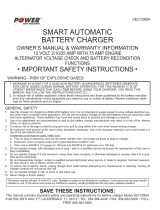4
3. Attach clamps to battery chassis as indicated in “Battery Installed in Vehicle” steps 5 and 6, and in “Battery
Outside of Vehicle” steps 2, 4 and 5.
Follow these steps when the battery is installed in a vehicle. A spark near the battery may cause an explosion.
WARNING: TO REDUCE RISK OF A SPARK NEAR THE BATTERY:
1. Position AC and DC cords away from hood, door, or moving engine parts.
2. Stay clear of fan blades, belts, pulleys, and other parts that can cause injury to persons.
3. Check polarity of battery posts. POSITIVE (POS, P, +) battery post usually has larger diameter than
NEGATIVE (NEG, N, –) post.
4. Determine which post of battery is grounded (connected) to the chassis. If negative post is grounded to
chassis (as in most vehicles), see 5. If positive post is grounded to the chassis, see 6.
5. For negative-grounded vehicle, connect POSITIVE (RED) clamp from battery charger to POSITIVE (POS, P,
+) ungrounded post of battery. Connect NEGATIVE (BLACK) clamp to vehicle chassis or engine block away
from battery. Do not connect clip to carburetor, fuel lines, or sheet-metal body parts. Connect to heavy gauge
metal part of the frame or engine block.
6. For positive-grounded vehicle, connect NEGATIVE (BLACK) clamp from battery charger to NEGATIVE (NEG,
N, –) ungrounded post of battery. Connect POSITIVE (RED) clamp to vehicle chassis or engine block away
from battery. Do not connect clip to carburetor, fuel lines or sheet-metal body parts. Connect to a heavy gauge
metal part of the frame or engine block.
7. When disconnecting charger, disconnect AC cord, remove clamp from vehicle chassis, and then remove
clamp from battery terminal.
8. Do not charge the battery while the engine is operating.
9. See operating instructions for length of charge information.
Follow these steps when the battery has been removed from a vehicle. A spark near the battery may cause an explosion.
WARNING: TO REDUCE RISK OF A SPARK NEAR THE BATTERY:
1. Check polarity of battery posts. Positive post (marked POS,P, +) usually has a larger diameter than the
Negative battery post (marked NEG, N, –).
2. Attach a 24-inch (minimum length) 6 AWG insulated battery cable to the Negative battery post (marked
NEG, N, –).
3. Connect the Positive (RED) battery clamp to the Positive battery post (marked POS, P, + or red).
4. Stand as far back from the battery as possible, and do not face battery when making final connection.
5. Carefully connect the NEGATIVE (BLACK) charger clamp to the free end of the battery cable connected to
the negative terminal.
6. Set the charge rate to appropriate setting according to battery size.
7. When disconnecting charger, always do so in reverse sequence of connecting procedure and break first
connection while as far away from battery as practical.
Note:
A marine (boat) battery must be removed and charged on shore. To charge it on board requires
equipment specially designed for marine use. This unit is NOT designed for such use.
• Check unit periodically for wear and tear. Take to a qualified technician for replacement of worn or defective
parts immediately.
• Read This Instruction Manual Before Using This Unit.
SAVE THESE INSTRUCTIONS
INTRODUCTION
Thank you for selecting the
Black & Decker
®
6 Amp Smart™ Battery Charger
. With proper care and use,
it will give you years of dependable service. This battery charger has a high charge rate of up to 6 amps, and
low charge rate of 2 amps. It is designed for charging only 12-volt lead-acid batteries — conventional
automotive, maintenance-free, marine deep cycle and gel — used in cars, farm equipment, boats, RVs and
SUVs, lawn mowers/garden tractors, motorcycles, personal watercraft, snowmobiles, ATVs and various
applications.
Smart™ Battery Chargers feature 3-stage, high-efficiency charging technology, built-in microprocessor control
that ensures fast, safe and complete charging of serviceable batteries.










